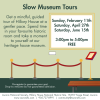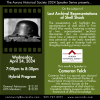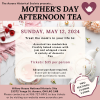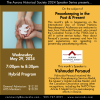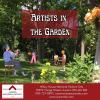Gummersall, Dorothy (2015) Transcript
Transcription
February 12th, 2015
Jonathan Koulouras (JK) interviewing Dorothy Gummersall (DG)
JK: Hello my name is Jonathan Koulouras, it is February 12th 2015 and I am interviewing Dorothy Gummersall at the Hillary House National Historic Site for the Let’s Talk Project. Hi how are you?
DG: I’m fine thank you.
JK: How long have you been living in Aurora for?
DG: I’ve been here fifteen years, probably sixteen by now, but fifteen. And I moved up here to downsize and I wasn’t born here; however the family came in 1851 and settled in south of Richmond Hill, which would be Langstaff. And they had family, a large family of about twelve children, and when I counted up all the grandchildren there were sixty-nine. So they kind of expanded all through the southern part of Ontario. However my line particularly stayed on Yonge Street, and my connection to Aurora is that my aunt and uncle owned a farm over in Snowball which is just you know, down towards the end of Wellington and they would, I would visit them. I’d be a small child at that particular time and however, we would come over, as I said many times, we would come to Aurora for ice cream and that would be at Cousin’s Dairy I, I assume, I was too small to remember that. So that’s my connection, really basically, other than getting and you know, just living in the proximity of Yonge Street which it was the longest street in Ontario and you know, visiting relatives and farms and things. My parents owned a dairy, North York Dairy, and we would have to deliver milk you know, to a particular area, so we got to know those people and, so I was just busy, I was you know, delivering milk and milk bottles and all sorts of things so, does that answer the question?
JK: Yes it does, how were the roads in town at the time?
DG: Pardon?
JK: How were the roads in town at the time?
DG: Well I remember pretty rough roads, they weren’t paved. Particularly when my father would take the milk truck and he’d come up Bathurst, and isn’t Bathurst that we connect and then you go into that little Snowball area, and I can remember coming across Wellington that was not paved, or if it was it was pretty, pretty rough you know. Yonge Street was paved because I was born in 1935, so ’34 Yonge Street was paved, but the other side streets, they weren’t. So I had a rough ride.
JK: So you were part of the Royal Canadian Navy?
DG: I was, I went in nursing at Women’s College in Toronto for three years and got my diploma, and then I had three brothers, two brothers and a sister that were in the Army, the Second World War, and a brother-in-law that was in the Navy and because I only had one brother-in-law I chose his suggestion that I go and join the Royal Canadian Navy, which I did. And as I said to Prince Andrew, when I met him, last year I believe he was here for lunch with the Queen’s York Rangers, I said to him, he asked me when I joined, and I said I started the process in 1956 and joined in ’57. And he was curious as to what my uniform was, cause it was a Nursing Sister’s uniform, but I didn’t have the veil on. If I’d had the veil he would’ve known, but he, I said to him, 19- and the occasion on which he asked me was, that was the beginning of the Cold War, 1957, so I did what they called a short term program and after three years I left the Navy, but I stayed on the shores of Vancouver for another couple of years, and was still connected to the, to the ship that I was on, which was the Skwymold?, so not quite the smooth. But anyway, that, that’s what I did, and I had a great time.
JK: And how was your time, how was your experience like?
DG: Working in the military hospitals?
JK: Yes.
DG: That sort of thing? Well it’s, it was certainly different. One of the ships was out for a period of six months and those fellows came back and you know, they had to go through all their, their physicals again, and we got a lot of injuries too that happened when they decided to slide down in the ships, as to taking the steps one by one. They would slide and they’d hit the bottom and get broken ankles, and yes, we did a lot, we had a lot of surgery and medicine.
JK: That’s interesting.
DG: Yeah, I could tell you a terrible tale, but I won’t. It, it was my first exposure to, to an individual which, we thought it was a kidney problem, but it actually turned out to be an infestation internal of round worms. And I was there when he vomited, and by the time I got to, to you know, put it in a bottle and save it sort of thing, it scared the life out of me because it poked its little head up like that and looked at me and I, I was holding my breath and, however I finally got it in the jar and I’m calling the doctor really fast and he said, “oh, that’s what the problem is.” So he got all sorts of medications to get rid of them, but that was my first introduction to something you read about, you know, but I never expected to see it. Yeah that was scary stuff.
JK: How has the area changed around Aurora throughout the years?
DG: Well I think we’ve increased our population. I worked for a while at the front desk or the Town of Aurora, for Info Aurora. We were there for ten years and I was able to you know, watch the population increase and in the various areas and I think mainly that’s, that Aurora is still a small town in many ways you know and, however we’ll see what the future brings for us.
JK: Regarding your family history, the Stephenson Family?
DG: Well that’s an interesting, that got me interested in genealogy, and I was told as a child that we were related to the father of the railways, George Stephenson and a cousin had already done a bit, a bit of history and produced a book, but he didn’t have any verification in the book, as to where he got his information from. So I took the book and started to do my own research and we didn’t have computer at that time either, so it was a lot of talking again, and a lot of going to cemeteries, and church records, and that sort of thing. I could only do so much because I was widowed quite young and I had three children to raise on my own so, I didn’t have a great deal of time, but I worked away at it and I to this day cannot find any verification that that’s true, other than having met another side of the family and that happened to be the forensic, or the pathologist rather, at York Central and he’s, he turned out to be a cousin. So he wanted to know the same thing, are we related? And since we were connected that way I said well it seems to point that we were, but I couldn’t get, and then I have cousins that are out in Alberta and they say the same thing. So I haven’t been able to get into the, the genealogical information in England is where it would verify. Even the name Gummersall is an interesting one too, cause that joins it to the war of 1812 and Gummersall is interesting because he’s, Thomas Gummersall Anderson is the sixth child of Captain Samuel Anderson, War of 1812 whose friend was Captain Thomas Gummersall. Those two man married sisters, Thomas Gummersall on this side, did not have any children, so his friend named Thomas Gummersall Anderson, and he turned out to be the first Superintendent of Indian Affairs for Canada.
JK: Wow that’s quite interesting.
DG: So there’s a lot of history there, genealogically, that you can get involved in if you have the time. Yeah, so yeah, genealogy’s been kind of my interest.
JK: That’s pretty cool. And you were involved in a church?
DG: In church? Yes, I’ve really had seventy years of singing in church choirs and always connected to the church. As a young girl there was the Canadian Girls in Training, which was the United Church and I attended those, I was part of that, moved then in my teen years to be part of the Anglican Young People’s Association, and then I went in training at the end of that time, and wherever I went, wherever the military sent me I would always attend a church and I would always sing in a choir. So I’ve been in a lot of choirs no matter where, you know, and at the moment I’m kind of on a sabbatical from church choir. That’s been one of the strong points of my lifetime, was belonging to the church choir. So the whole family was musical, that’s the unfortunate part I guess but, the, last year, not last year, the year before, we were singing Handel’s Messiah down at the Presbyterian Church in Richmond Hill and my aunt, who was the organist and choir-director for St. Mary’s Richmond Hill, was buried in the cemetery behind. So I came down to sing with the Presbyterian choir for Messiah, so afterwards I said, I think my aunt must be turning over by now, I said, she was a beautiful contralto and I’m a squeaky soprano. So anyway, yeah, they were all musical, all musical.
JK: How about your volunteer time at Info Aurora?
DG: Well I did ten years volunteering there, usually I started out doing Monday, was my day. We had other, you know, volunteers for the other days, and whatever time you could donate, but I always did a full day on a Monday and I was also the emergency person to call if somebody was sick or they couldn’t get in; because I was living just sort of behind the Town Hall there, I could get there quickly. Yes and it’s, some people are quite comfortable chatting with people, and others are not, and to just have somebody to walk up to you and then you have to solve a problem is quite tensing for some people, it’s kind of hard. One of the girls that we had, I felt sorry for her because she wouldn’t answer the telephone, if she was working with me that was fine I answered the phone, but she apprehensive to for fear of what might be the call you see. So yes, we would get people phoning us that we would direct them to the police if that’ where the problem, it’s problem solving, is basically what it is. Lot’s of interesting questions like, “well there’s a swan on the road road, where does the swan, what do I do about that?” You know, and I, questions like that, and then there was all there “Well where do I go to get something done?” You know, not only in the building but I remember directing one man to a lawyer because of the difficulty he was having and I called the lawyers office and said that he, “well send him right down,” you know, so I solved his problem for him. There was just, everyday there was something to solve you know, I enjoyed it. It was a little bit like the, like the emergency room you know, people coming right in and you just have to you know, make them feel comfortable so they can get their questions out. I enjoyed it.
JK: Sorry, Cousin’s Dairy?
DG: That was the ice cream cones as a little girl. You see I’d go to the farm and my father tried to put me on a horse and I, actually it was one of the movies I was watching, the son was on the horse and he had the plough behind him, well that’s what my father was trying to get me to do, only it didn’t work out that way. I should’ve been a boy I guess, but I got off the horse and I guess that was the end of that. I might’ve fallen off it for all I remember, but it was just not my thing.
JK: What is your most memorable Aurora moment?
DG: A moment?
JK: Yes.
DG: Oh, well I would have to say meeting Prince Phillip, Andrew rather. That was, I had met some of the royal family before hand, when I was in the military. Princess Margaret came through and I was a couple of feet from where she, she was being escorted, and then there was the Queen Mother before she passed away. I met her down at the, the Toronto Town- Toronto City Hall pardon me, city, and she was coming up and I was standing on the edge and I happened to say, “oh isn’t she cute,” cause I expected her to be, to be taller, I don’t know why, but she was short, and she was cute you know, so, and she stopped and she must’ve heard me, I was embarrassed. I stepped back and hid behind a gentleman so she couldn’t see me, he was nice and tell and I just hid and she stopped and looked around to see where the voice came from. I was really embarrassed, but she was cute. So I you know, just got to know a lot of people and you know, dignitaries particularly. When I was in the military I flew back and forth, I had nine trips across Canada, some to come home and some I flew with the Lieutenant Governor of British Columbia, Mr Pearkes and they made room on many flights if I wanted to fly, and it was all free, and I flew down to Washington D.C., and I flew with an Air Vice Marshal, and believe it or not we landed beside, and taxied beside Puschovs from Russia, his airplane, so there was lot’s of security around, so it was kind of exciting. So I got, I got, you know, I got to know people that way, and they were very very respectful, everybody was being you know, in the military, to the nursing sisters, they were highly prized, so I was honoured really, to belong and I still see the nurses you know, at Camp Borden, and I go up for Remembrance Day and the last few years I’ve been able to put the wreath down for whatever organization. Some years before the Afgan War really got, I did the wreath for the mother and so that was quite an honour to do that part. Anyway that’s it for Aurora, Aurora was just meeting, now when I go shopping people do a double take, “where have I seen you before?” I said “paying your taxes.” So yeah, front desk that was a interesting, interesting part, of my life.
When I came up here in ’97 I was with the Richmond Hill, I’m the founding member of the Richmond Hill Historical Society, along with Pat Hart, cause when I moved up there I moved to Richmond Hill from North York where I belonged to the historical group there. So I moved to Richmond Hill and was busy with ground work of getting that organized, simply because there wasn’t anything and you know, you don’t need a university degree to start something. There was a need and I got busy to fill it, and so I knew Pat Hart from North York and a lot of pictures and things that my mother had went to North York; however in and amongst her etchings I did find one of the pictures that belongs to Aurora and that was the, the, which I’ve given them, the historical society here has a copy somewhere, but the original picture, I was curious as to why my mother had it in her etchings, and it was my daughter who was looking at the picture one day with the light shining on the picture and the picture had a dot on one of the men. So I took it from my daughter and I looked and I said, “Oh that’s, that’s Uncle Charles.” Like this, my father’s brother; however, you know I had three Uncle Charles; however it was the Uncle Charles Stephenson and so that’s, and then it dawned on me that I always had nice shoes when I was a little girl. You know, the little black shoe that would come across the top of your foot and, and attach at the side. I had, I always had those and they were always nice and leathery and that sort of thing, but I always had nice shoes so that’s the connection I think to Aurora, with the leather company, that he probably worked with them for a time, cause he’s in that pictures. I think there was three hundred in the picture, pretty close to that I think. So yeah, I was trying to, you know to, Jacqueline (Stuart) didn’t recognize it though, and neither did John (McIntyre) unless they’ve changed their mind by now, I don’t know, but when I first tried to track it down. So that’s another con- and of course when I traveled around Ontario with my parents and that, we had relatives up in Gravenhurst, we would always take, Yonge Street was always the main route to go anywhere, was Yonge Street. So it, I had long memories of that, and the streetcar even. My mother would give the streetcar driver twenty-five cents to let me off at Richmond Hill, I’d get on at Willowdale, and let me off at the station at Richmond Hill so I could visit my aunt and, she would meet me, of course, and then I’d go and play with my cousins and yeah. She would phone her and our phone, first phone number was 54 in Willowdale, 54, the old kind, not this kind.
JK: Thank you for coming in.
DG: Oh you’re welcome, thank you.
JK: For doing the interview for the historical society.
END. 25:15




